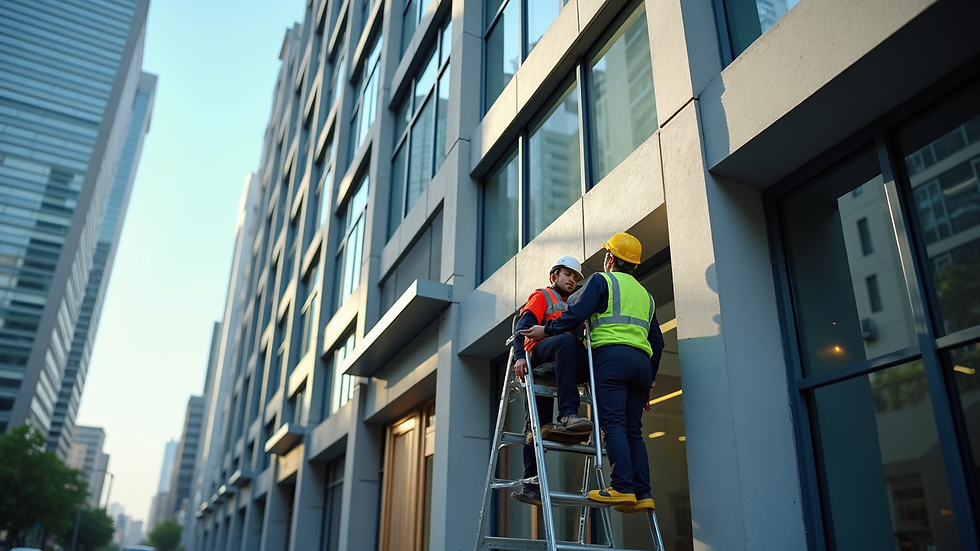5 Hidden Costs of Deferring Maintenance
- Crown Royalty Property Services

- Feb 9
- 3 min read
For every dollar saved by deferring maintenance, there comes a four-dollar increase in future capital renewal costs.

By Crown Royalty Management Property Services
Every year, millions of dollars in necessary property maintenance are deferred by businesses and property owners. The most common reason? Budget constraints. However, insufficient staffing and a lack of understanding of proper maintenance needs also contribute to this costly oversight.
When maintenance is delayed, the long-term financial impact can be severe. Studies show that for every dollar "saved" by postponing maintenance, property owners can expect to pay four times as much in future repair or replacement costs. In some cases, the total long-term cost can be more than 15 times what would have been spent on timely maintenance.
To protect your property’s value and operational efficiency, it’s crucial to understand all the hidden costs of deferred maintenance. These costs go beyond the obvious and can result in emergency repairs, shorter asset life, reduced efficiency, safety risks, and collateral damage.
1. Emergency Repairs
A well-maintained property follows a proactive approach to maintenance—tasks are scheduled and completed before problems arise. However, deferring maintenance forces property owners into a reactive stance, responding only when an issue becomes urgent.
When critical systems fail unexpectedly, repair costs skyrocket. Emergency service calls, after-hours labor rates, and rush orders for replacement parts can add significant expenses. If a major system such as plumbing or exterior lighting fails, operations may be disrupted, requiring temporary solutions that further inflate costs.
In contrast, a proactive maintenance plan minimizes the risk of costly emergency repairs and ensures the property remains functional and safe for tenants, employees, and customers.
2. Shorter Asset Life
Every asset on a property—whether it's roofing, pavement, lighting, or landscaping—has a finite lifespan. Proper maintenance extends this lifespan, whereas neglect accelerates deterioration.
For example, ignoring small cracks in pavement can lead to water infiltration, which worsens the damage and results in costly resurfacing or replacement. Similarly, failing to repaint exterior trim allows moisture intrusion, causing rot that necessitates full material replacement instead of a simple touch-up.
Mechanical systems also suffer under deferred maintenance. HVAC units that aren’t regularly serviced accumulate dust and debris, causing components to work harder and wear out faster. A system that could last 20 years with proper maintenance might fail in 10 years or less under neglect.
3. Reduced Equipment Efficiency
Deferred maintenance negatively impacts energy efficiency, increasing operational costs for property owners. Mechanical systems, particularly HVAC, plumbing, and electrical infrastructure, require routine servicing to operate at peak performance.
For example, an HVAC system that isn’t regularly cleaned and tuned will consume significantly more energy to maintain the same level of comfort. Clogged filters, dirty coils, and neglected ductwork lead to higher utility bills and premature system failure.
A proactive maintenance strategy ensures optimal efficiency, keeping energy costs down and reducing the frequency of expensive equipment replacements.
4. Safety and Liability Risks
Neglected maintenance doesn’t just affect property value—it also creates serious safety hazards. Loose handrails, cracked walkways, poorly lit areas, and malfunctioning automatic doors can all lead to accidents and potential liability claims.
Beyond the immediate safety concerns, deferred maintenance can result in compliance violations. Fire codes, ADA regulations, and municipal safety standards require property owners to maintain safe premises. Failing inspections can lead to fines, legal action, or even forced closures.
Ensuring regular inspections and timely repairs protects both property owners and tenants from costly liability and compliance issues.
5. Collateral Damage
When one component of a property fails, the damage often extends far beyond the initial issue. A leaking roof, for instance, doesn’t just require patching—it can cause water damage to insulation, ceilings, electrical systems, and interior spaces.
A clogged drain that overflows can damage flooring, walls, and foundational structures, requiring expensive restoration work. Delaying maintenance on a small issue can quickly escalate into a much larger and more expensive problem.
By addressing minor maintenance concerns early, property owners prevent cascading damage and avoid the compounded costs of large-scale repairs.
The Cost of Inaction
If property owners want to maintain the value and efficiency of their investments, they must take a proactive approach to maintenance. Developing a structured maintenance plan and budgeting for regular upkeep can save thousands of dollars in future expenses.
Crown Royalty Management Property Services specializes in exterior maintenance solutions that help property owners protect their investments. Our proactive maintenance programs prevent costly emergency repairs, extend asset lifespans, and improve property efficiency.
Don’t wait for maintenance issues to spiral out of control. Contact us today to schedule a property assessment and ensure your property remains in top condition.
Crown Royalty Management Property Services – Protecting Your Investment, Preserving Your Property.




Comments